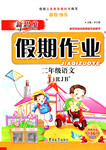题目内容
Imagine you’re at a party full of strangers.You’re nervous.Who are these people?How do you start a conversation?Fortunately,you’ve got a thing that sends out energy at tiny chips in everyone’s name tag(标签).The chips send back name,job,hobbies,and the time available for meeting—whatever.Making new friends becomes simple.
This hasn’t quite happened in real life.But the world is already experiencing a revolution using RFID technology.
An RFID tag with a tiny chip can be fixed in a product,under your pet’s skin,even under your own skin.Passive RFID tags have no energy source—batteries because they do not need it.The energy comes from the reader,a scanning device(装置),that sends out energy(for example,radio waves) that starts up the tag immediately.
Such a tag carries information specific to that object,and the data can be updated.Already,RFID technology is used for recongnizing each car or truck on the road and it might appear in your passport.Doctors can put a tiny chip under the skin that will help locate and obtain a patient’s medical records.At a nightclub in Paris or in New York the same chip gets you into the VIP(very important person) section and pays for the bill with the wave of an arm.
Take a step back:10 or 12 years ago,you would have heard about the coming age of computing.One example always seemed to surface:Your refrigerator would know when you needed to buy more milk.The concept was that computer chips could be put everywhere and send information in a smart network that would make ordinary life simpler.
RFID tags are a small part of this phenomenon.“The world is going to be a loosely coupled set of individual small devices,connected wirelessly,”predicts Dr.J.Reich.Human right supporters are nervous about the possibilities of such technology.It goes too far tracking school kids through RFID tags,they say.We imagine a world in which a beer company could find out not only when you bought a beer but also when you drank it.And how many beers.Accompanied by how many biscuits.
When Marconi invented radio,he thought it would be used for ship-to-shore communication,not for pop music.Who knows how RFID and related technologies will be used in the future.Here’s a wild guess:Not for buying milk.
1.The article is intended to ______.
A.warn people of the possible risks in adopting RFID technology
B.explain the benefits brought about by RFID technology
C.convince people of the uses of RFID technology
D.predict the applications of RFID technology
2.We know from the passage that with the help of RFID tags,people ______.
A.will have no trouble getting data about others
B.will have more energy for conversation
C.will have more time to make friends
D.won’t feel shy at parties any longer
3.Passive RFID tags chiefly consist of ______.
A.scanning devices
B.radio waves
C.batteries
D.chips
4.Why are some people worried about RFID technology?
A.Because children will be tracked by strangers.
B.Because market competition will become more fierce.
C.Because their private lives will be greatly affected.
D.Because customers will be forced to buy more products.
5.The last paragraph implies that RFID technology ______.
A.will not be used for such matters as buying milk
B.will be widely used,including for buying milk
C.will be limited to communication uses
D.will probably be used for pop music
1.D
解析:这是一道主旨题。本文着重介绍了RFID技术以及其未来的一些应用前景。主要干扰项是B选项,本文并没有太多介绍这项技术的现实应用,主要是想象未来利用这一技术可以实现很多原来不可预料的一些应用。
2.A
解析:这是一道推断题。根据第一段“The chips send back name,job,hobbies,and the time available for meeting—whatever.”可以判断出获得别人的信息将更加容易。
3.D
解析:这是一道推断题。根据第三段“An RFID tag with a tiny chip can be fixed in a product”可知RFID的标签包括一个芯片。
4.C
解析:这是一道推断题。根据倒数第二段的最后一句,啤酒公司会知道你何时买的啤酒,何时喝的,以及搭配吃了多少饼干,这暗示在私人信息保密将成为问题。
5.B
解析:这是一道推理题。根据最后一句“Here’s a wild guess:Not for buying milk.”这句的意思是不知是买牛奶,也就是应用将十分广泛。

 新思维寒假作业系列答案
新思维寒假作业系列答案